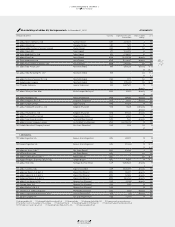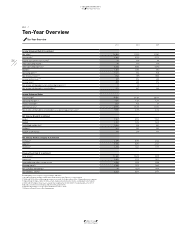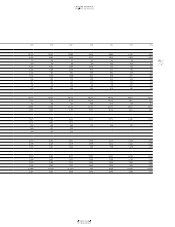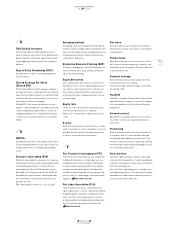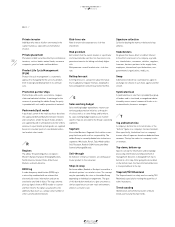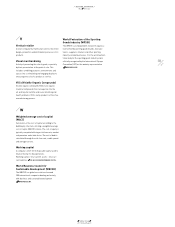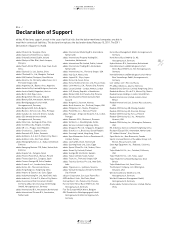Reebok 2011 Annual Report Download - page 235
Download and view the complete annual report
Please find page 235 of the 2011 Reebok annual report below. You can navigate through the pages in the report by either clicking on the pages listed below, or by using the keyword search tool below to find specific information within the annual report.
adidas Group
2011 Annual Report
ADDITIONAL INFORMATION
231
2011
05.2 Glossary
Licensees
Companies that have the authorisation to use the
name of a brand or business for the production and
sale of products. For example, for adidas, licensed
products include cosmetics, watches and eyewear,
for Reebok, fitness equipment and for TaylorMade-
adidas Golf, bags and gloves.
Lien
The right to take and hold or sell the asset of a
debtor as security or payment for a debt.
Liquidity I, II, III
The liquidity ratio indicates how quickly a company
can liquidate its assets to pay for current liabilities.
Liquidity I:
((Cash + short-term financial assets) / current
liabilities) × 100.
Liquidity II:
((Cash + short-term financial assets + accounts
receivable) / current liabilities) × 100.
Liquidity III:
((Cash + short-term financial assets + accounts
receivable + inventories) / current liabilities) × 100.
M
Market capitalisation
Total market value of all shares outstanding.
Market capitalisation = number of shares
outstanding × current market price.
Marketing working budget (MWB)
Promotion and communication spending including
sponsorship contracts with teams and individual
athletes, as well as advertising, events and other
communication activities, but excluding marketing
overhead expenses. As marketing working budget
expenses are not distribution channel-specific,
they are not allocated to the Group’s operating
segments.
Mono-branded stores
adidas, Reebok or Rockport branded stores that
are not operated or owned by the adidas Group
but by franchise partners. This concept is used
especially in the emerging markets such as China,
benefiting from local expertise of the respective
franchise partners
SEE ALSO FRANCHISING
.
N
Natural hedges
Offset of currency risks that occurs naturally as a
result of a company’s normal operations, without
the use of derivatives. For example, revenue re-
ceived in a foreign currency and used to pay known
commitments in the same foreign currency.
Net borrowings/Net cash
Portion of gross borrowings not covered by the sum
of cash and short-term financial assets.
Net borrowings/net cash = short-term borrowings
+ long-term borrowings – cash – short-term finan-
cial assets.
Non-controlling interests
Part of net income or equity which is not attribut-
able to the shareholders of the reporting company
as it relates to outside ownership interests in sub-
sidiaries that are consolidated with the parent com-
pany for financial reporting purposes.
O
OHSAS 18000
OHSAS 18000 is an international occupa-
tional health and safety management system
specification.
ÖKO-Tex Standard 100
An international testing and certification system
for textiles, defining and limiting the use of certain
chemicals.
Operating cash flow
Operating cash flow is comprised of operating
profit, change in operating working capital and net
investments.
Operating cash flow = operating profit +/– change
in operating working capital +/– net invest-
ments (capital expenditure less depreciation and
amortisation).
Operating lease
Method of leasing assets over periods less than
the expected lifetime of those assets. An operating
lease is accounted for by the lessee without
showing an asset or a liability on the balance sheet.
Periodic payments are accounted for by the lessee
as operating expenses for the period.
Operating overheads
Expenses which are not directly attributable to
the products or services sold, such as costs for
distribution, marketing overhead costs, logistics,
research and development, as well as general and
administrative costs, but not including costs for
promotion, advertising and communication.
Operating working capital
A company’s short-term disposable capital which
is used to finance its day-to-day business. In
comparison to working capital, operating work-
ing capital does not include non-operational items
such as financial assets and taxes.
Operating working capital = accounts receivable +
inventories – accounts payable
SEE ALSO WORKING
CAPITAL
.
Option
Financial instrument which ensures the right to
purchase (call option) or to sell (put option) a par-
ticular asset (e.g. shares or foreign exchange) at a
predetermined price (strike price) on or before a
specific date.
P
Performance business
In the sporting goods industry, business related to
technical footwear and apparel, used primarily in
doing sports.
Price-earnings ratio (P/E)
A company’s share price divided by its current or
future diluted earnings per share. The P/E ratio is
used by investors as a fundamental measure of the
attractiveness of a particular security versus other
securities or the overall market. It is usually more
useful to compare P/E ratios of one company to
other companies in a similar industry. In general, a
high P/E ratio suggests that investors are expecting
higher earnings growth in the future compared to
companies with a lower P/E.
Price points
Specific selling prices, normally using “psycho-
logical” numbers, e.g. a product price of US $ 99.99
instead of US $ 100.


